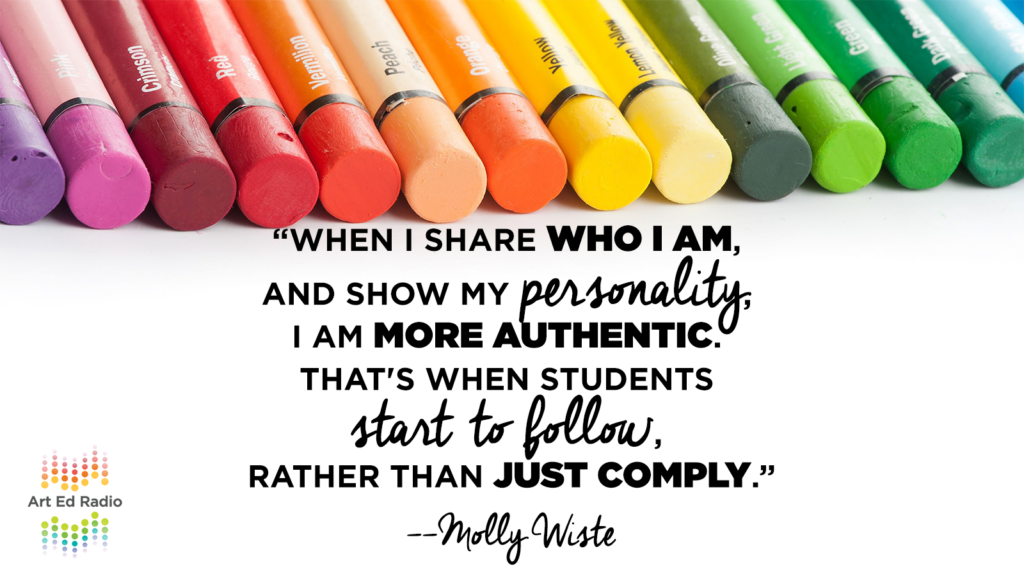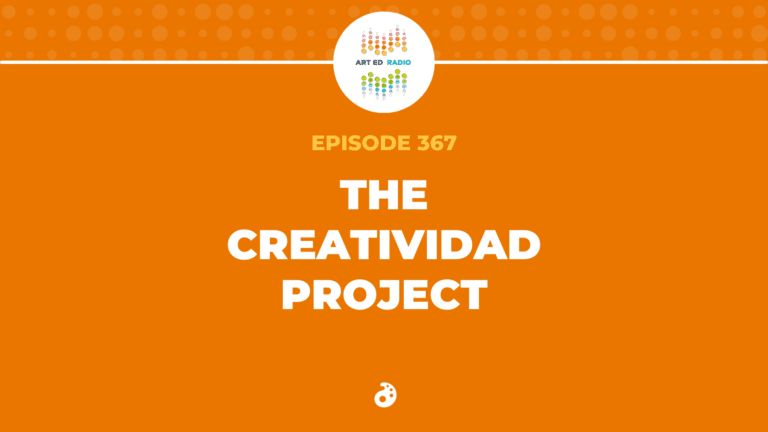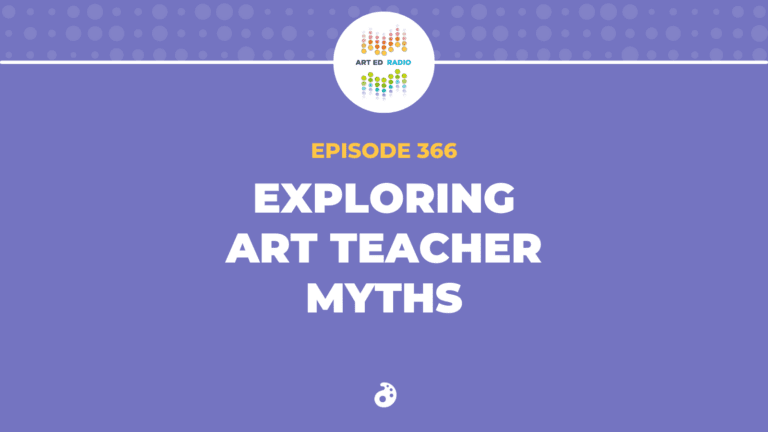Taking over a program is never an easy task. But when you follow a legendary teacher, it is even more difficult. It’s important to make the program your own, and this episode has great advice on how to do just that. Molly and Tim discuss how previous teachers’ pedagogy and teaching style affect how a new teacher is received (5:30), why you need to share your ‘why’ with your students (10:30), and what to do when you have student pushback and issues with discipline (12:45). Full episode transcript below.
Resources and Links:
- Starting an Art Program from Scratch
- Proven Strategies for Recruiting Students for Your Program
- How to Stay Positive when Faced with Change
- 7 Ways to Hit Your Stride in the Art Room

Transcript
Welcome to Art Ed Radio, the podcast for art teachers. This show is produced by The Art of Education, and I’m your host, Tim Bogatz. Taking over a new art program is never an easy endeavor. There’s so much to take on logistically — organization, supplies, curriculum, setup, the whole nine yards — and that’s before you begin thinking about coming in as a new teacher, and how you’re going to deal with the students who are already there. How are you going to establish your culture, get to know the kids, get them to buy in to your vision for the program, and what it all should look like?
And, more importantly, how would you be able to do that if you’re following a legendary teacher? When you’re following someone who’s been successful, who has endeared themselves to students and staff and everyone outside of the school, that is going to be so incredibly difficult. If you’re following a legend, you have so much to do. When you’re trying to reverse a negative culture, it’s easy, right? People want to buy in, they want to be part of a turnaround, or be part of something that’s getting better, but if you’re taking over a culture or a program that’s already amazing, it’s a whole different ballgame. People are resistant to change, especially if it’s something they like, and they’re going to be resistant to what you want to do as a teacher.
Now, when I took over at my high school, I don’t know if I would call the previous teacher a legend, but he was someone who was beloved by the students, and that made the culture, the buy-in, and the classroom management really difficult. Kids wanted to do things how they had always been done. They were resistant to change, and they were resistant to me as a teacher. It was just an incredibly difficult couple of years as I was trying to establish the culture I wanted to see in my classroom, and I can’t imagine trying to find success after taking over from someone who was also beloved by colleagues, and administration, and parents, and the community at large.
Today’s guest has had to do exactly that. Molly Wiste, an art teacher from Minnesota and an AOE instructor, took over a couple years ago from someone who was an absolute legend. I’ll let her tell you her story, and tell you how she’s coping and dealing with her situation. We’re going to talk motivation, classroom management, pressures and expectations, and how to bring your personality into the program you’re trying to shape, which is something I think can be a good conversation for everyone to hear. I’m really eager to share experiences and hear all of her stories, so let me go ahead and bring her on right now.
And Molly Wiste is joining me now. Molly, how are you?
Molly: I’m doing really good. Thanks, Tim.
Tim: Good. I am excited to have you here, and we’re going to chat just a little bit, I talked in the intro about my experience taking over a program, and kind of everything that you go through when you’re trying to make it your own. So, can we just start out with you telling us your story? Like, what was your art room and your program looking like when you first took over?
Molly: Sure, yeah. I’ve been in the same district for about 12 years, so I kind of had a unique situation where I knew the teacher that I was taking over for, because I had worked with him and near him, and he was actually kind of my mentor for a little while too. He fully admitted he was a complete hoarder — he saved everything — so when I took over, it was packed full of stuff, and, I mean, I kind of understood. He didn’t know what I wanted, what I didn’t want, what to get rid of, so he was kind of like, “I’ll just leave it all for you.” And I’m going, “No, no, please don’t.” So we actually — and I tell him this story — four full-size dumpsters later-
Tim: Oh my goodness.
Molly: … had the room kind of cleaned out and ready to start fresh. One cool thing was he taught choice-based, and he’d been teaching choice-based for like 30 years. When I was saying “TAB” to him, you know, Teaching for Artistic Behavior, he was like, “I don’t know what that is,” and I’m going, “Well, you’re doing it.” So I kind of had that going for me. He was great at building relationships, so, I mean, like they were grilling out every Friday, and he was really light in assessments, and so he had really strong relationships, but it was not the same that I was going to do things, so it was a little bit tough coming in.
Tim: Yeah, that definitely can be, and that kind of leads into some of the other things that I want to talk about. But you mentioned that with relationships, and so, how much did that affect how kids interact with you? Like, how much did you hear from kids about the teacher that was there before? You know him, but how much did you hear about kids, and how much did what he was doing … I mean, obviously, you’re not going to do grilling out with them every week, but how much did what he did affect what you wanted to do?
Molly: Oh, it was brutal. It was completely brutal. He was a legend. He’d been there forever, and he … Everybody knew him, he had been involved with so many different things, when he left, it was just brutal. And we kind of joked about it as he was leaving, and he was apologizing for what I was about to have to go through. Even the principal said, “Are you pretty much ready for two years of hell? Because you know what’s coming.” You know, he had a bunch of murals up in the room and stuff, and, not totally my decision, but the school decided, you know, they’ve been there for 30 years, it’s time to paint the room. So that didn’t help my case either. The first year, I had students stopping by, and they would just bop their head in, and I’m going, “Hey, how’s it going?” and they’re like, “It looks like crap in here. I can’t believe you ruined everything.” And I’m going, “Oh.”
And this was, like, constant the first year. People wouldn’t … They weren’t coming to see me, they were coming in to see how much I’d ruined the place, and … Because all his stuff was gone, and the walls were painted. Actually, when people started popping their head in, I was like, “Oh boy, here we go again,” you know?
Tim: Oh, wow.
Molly: So there was a lot of complaining about the room, and how I was doing things differently, and definitely complaining about not grilling out every Friday, so I heard about that a lot.
Tim: Yeah, okay, so let me ask you, though … I want to talk about relationships a little bit more, and kind of how you developed those, but just kind of along with the idea of taking over and following somebody who is so beloved, even though your pedagogies match up, do you still feel any pressure to continue working with different media, or teaching a particular lesson that he’s done before, or … Like, how much did you feel like you had to follow in his footsteps?
Molly: You know, there were some things that he did that had become kind of a cultural norm for the area. For example, he started a decoy carving program, and they were carving spearing decoys, for through the ice, and they actually make similar things in the shop class, and it was kind of expected, and they did a lot of airbrush painting. And those are two things that I did continue on with, the decoy carving and the airbrush painting, and I don’t think it would have been great if I got rid of them right away. So those are some good things.
Also, though, I know he did a ton of stuff for the community. I mean, and I do things for the community, but it was way above and beyond. He was firing stuff for different people that just wanted to do ceramics but didn’t have a kiln, he was painting signs for businesses, like him personally, and doing it all for free, just out of the kindness of his heart. People would come in and be like, “We need 30 t-shirts by tomorrow, airbrushed,” and he would stay until 10:00 at night and paint them. You know, I do some of this stuff, but it’s to the point where I’ve had to just say, “No, I’m sorry,” “No, I’m sorry,” because I have young kids, and I can’t stay there until 10:00 every night, so …
Tim: Yeah, that puts some pressure on you too. That’s a bad feeling.
Molly: Yeah.
Tim: But, you know, let me ask you this. It sounds like you’re making a lot of enemies there when you first took over, between not airbrushing t-shirts and ruining the classroom. But at the same time, it’s still your classroom, and because this is your space now, and kids need to get to know you, I guess the question is, how much do you put yourself out there? Like, how much do you let kids know about you as a person, and as a teacher, and how does that affect what’s going on in your classroom? How do you start to build those relationships?
Molly: Right, yeah. I had to do a lot of soul-searching and thinking, and I knew it was going to be rough, but it was as bad as I thought it would be. One thing that kind of came to mind with this was … You know Simon Sinek? He’s … Did I say that right?
Tim: Yeah, yeah, I believe so.
Molly: When I’m always reading names, you’re never sure how to pronounce them.
Tim: Right, you always see it in print, but you never hear it.
Molly: Right.
Tim: Yeah, I believe that’s right, though.
Molly: But I have this quote by him that says, “If your actions inspire others to dream more, learn more, do more, and become more, you’re a leader,” and the key there being “actions,” and I love that he’s always talking about sharing your Why. I feel like it’s really important to share my Why with students, because when I start sharing where I get my inspiration, my passion, my actions as an artist and a teacher, I’m really authentic, and they’re more likely to follow me, rather than just be compliant, and that played a big factor in me kind of winning them over. My sharing also kind of affects the feel in the classroom. When I can kind of make fun of myself, share my experiences, it really lightens the mood, and it helps them to be more comfortable with who they are in the space too. And it really made it harder for them to hate on me, because it humanizes you as a teacher, and it helps you to build those relationships more quickly, even though it still feels like forever.
Tim: Yeah.
Molly: Yeah, so it was tough, but I definitely felt like that helped out a lot. And then … I’m just going, I’m on a roll with quotes here, but as I was thinking about this too, I’ve been reading a lot of Brené Brown’s stuff lately, and just about that vulnerability piece, and one thing that she says is “Vulnerability is the birthplace of innovation, creativity, and change,” and that “courage starts with showing up and letting ourselves be seen.” And, man, sometimes you can feel really vulnerable sharing yourself and your story with your students, but I’ve never had it backfire. Like, I always think it’s a good thing.
Tim: Yeah, I would agree with that, and like you said, it is really tough to put it out there, but I think that is a really good thing. And like you said, it makes kids … It makes them second-guess that mindset of really wanting to dislike you. That kind of gets me thinking about the next question, too. How much pushback did you get? I mean, you have all of these great ideas, you’re very willing to be open with kids, but at the same time, did you still get pushback? And were there discipline issues, were there motivation issues?
Molly: Yeah, yeah, I definitely got major pushback. One thing, too, the teacher that left, he was famous for saying things about, like, “There’s no place for technology in the art room at all,” and I actually use quite a bit of technology to make digital portfolios, and I have students do things with Photoshop. So any time I would bring up tech stuff, they were just like, “Ahh,” and they would quote him, “There’s no place for technology in the art room,” and I’m going, “Oh no, they’ve been brainwashed against me.” And, I mean, I got tons of flak for that grilling thing, and for a while, anything that I asked them to do, it was like pulling teeth.
You know, the relationship-building took a while, but as they got to know me better as a person, like I said, it was a little bit harder for them to be as mean to me. At first, it went from total pushback, whining, complaining, not wanting to buy in, to after a while, they would whine, but not as loudly, and then they’d say, “Okay, Mrs. Wiste.” It slowly changed over, but it was really rough, and it was almost the whole first year that was pretty brutal. I had to really just remain calm. As much as I’m feeling like I’m losing it on the inside, I had to … Because if they knew that it was getting to me, it would’ve gotten way worse.
Tim: Yes, yes.
Molly: So keeping my calm, and playing it off like it’s not a big deal, but then addressing students individually, really helped out. But I hardly ever send people to the office, and I even had to send a few people to the office.
Tim: Yeah. Hey, you do what you gotta do, but …
Molly: Yeah.
Tim: So, let me ask you this. You say it took about a year for things to turn around. In my experience, when I took over, it took a full couple years before I felt like kids were where I wanted them to be, as far as discipline and motivation and all that kind of stuff. So I guess the question is, can you describe what that looks like when their mindset sort of shifts? Like, how can you tell when kids are starting to buy in to what you’re selling, or really willing to do what you want them to do? What does that look like?
Molly: I just saw motivation increase a lot. At first, there was a lot of off-task behavior, and the complaining, whining. I was spending more time on behaviors and less time on art.
Tim: Yeah.
Molly: And like you said, it takes a while. I’m in my second year now, and it’s still not perfect, but I find myself having conversations with students about their art, and all of a sudden, I’m realizing, “Hey, they’re not really complaining anymore.” I’m not having more confrontational behavior things, I’m actually talking to them about their art, and that’s just so refreshing to see that switchover. You can kind of feel the mood in the classroom change, and you can feel the environment change, and it’s a more welcoming place as they start to accept what we’re doing and where we’re going, as they see my vision and they’re buying in to it, so …
Tim: Yeah, that’s a really good description. I feel like you put that together really well. Let me just ask you one last question, then we’ll get you out of here. If people are listening to this and they know that they’re taking over a program next year, or maybe they’re in the middle of taking something over, and it’s been kind of a tough transition, what advice would you have for them? Where would you recommend people start when it comes to building a program, or if they’re taking over something brand-new, they’re feeling completely overwhelmed, what’s one point they can start at, or one place they can begin to kind of get that mindset to shift, and get things going in the right direction?
Molly: I would say the biggest thing that I started doing is I really started to realize that they weren’t mad at me, they didn’t hate me; they were really sad that he was gone, and they just didn’t have the relationship with me yet. When I realized that, I kind of stopped being angry at them for being so mean to me, because then I realized, “You know what? I just need to address this head-on,” because I was trying to avoid the topic. So I would say, address it head-on. I just got to the point where I said, “You know what, guys? I’m not him, and I know that you guys are really sad and hurt that he’s gone.” And I just kind of acknowledged that they missed him, and I said, “You know what? I’m never going to be him, but we’re going to have fun too.”
So just kind of, I would say, address it head-on, and acknowledge their pain and sadness, if it is a legend that left that they’re really missing. And then you’ve got to give it time. It feels awful for a while, but people are going to … They’re either going to come around or they’re going to graduate, and either way … Like, right now, I loved my seniors last year, and they’re actually students that I’ve known for a long time, but I am so glad they’re gone, because they were giving me the most grief, and I think that helped a lot that they graduated. And then I just really work on building relationships and trusts with the underclassmen. You know, not that I’m not doing it with juniors and seniors, but they’re the ones coming up that are going to be my program in the next few years, so I’ve really been working with the freshmen and sophomores a lot to have them understand my Why and get the buy-in. So I would say, address it head-on, give it time, and then build those relationships with the underclassmen.
Tim: Yeah, that sounds really good. I mean, I think that’s some excellent advice, and I would probably be saying just about the same thing. I think that’ll be a good place for us to wrap it up, so, Molly, thank you very much for joining me. It’s been a really good conversation, and I appreciate all of your stories and all of your advice, so thank you.
Molly: Yeah, thanks, Tim. It’s always fun to talk to you.
Tim: Wow, awesome stories and awesome conversation with Molly, so a big thank-you to her for coming on and sharing all of her experiences. I’m still fascinated by grilling out every single week. It’s probably going to take me a while to get over that one. But, really quickly, before we wrap up, I want to remind you to sign up for the Art Ed Now Conference. It is less than one month away, February 3rd is the date, and it is the best day of professional development that you can find. As I said last week, Alexa Meade, the amazing contemporary artist, is going to be our featured presenter. There are over 20 other incredible presentations that cover every topic in art ed. I’ve seen some previews of some of the presentations, and you are going to love them. There are ones that are hilarious, there are presentations that are inspiring, and every single one is going to both entertain you and make you think. So, make sure you check out all the details and register at artednow.com. You don’t want to miss it.
Now, one closing thought that I think is good for everybody to take with you from this. Molly was talking about authenticity, and how you need to share things with your students. You need to share who you are, share your personality, share what you do as an artist, because that helps you come across as someone authentic, and it’s something that kids will respond to. Here’s what she said that I think is worth remembering, the quote from her that we’ll leave you with. “When you show your authentic self, that’s when kids will start to follow, not just comply.”
Art Ed Radio is produced by The Art of Education, with audio engineering from Michael Crocker. Remember that you can sign up for our email list at artedradio.com. Send us any thoughts, questions, concerns, or anything else you want to chat about at radioguys@theartofed.com. We’ll see you next week.
Magazine articles and podcasts are opinions of professional education contributors and do not necessarily represent the position of the Art of Education University (AOEU) or its academic offerings. Contributors use terms in the way they are most often talked about in the scope of their educational experiences.



